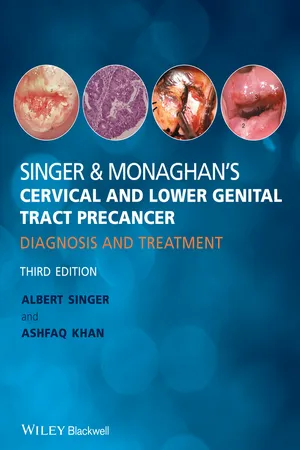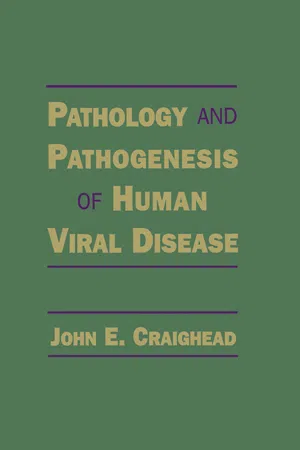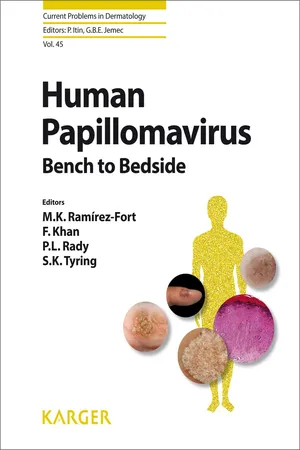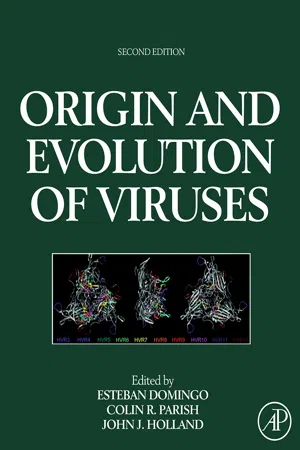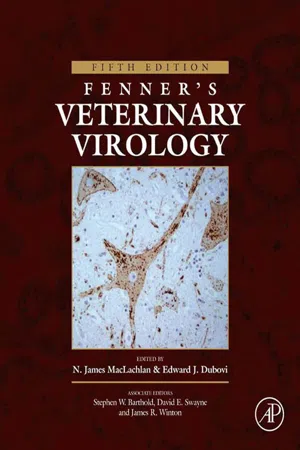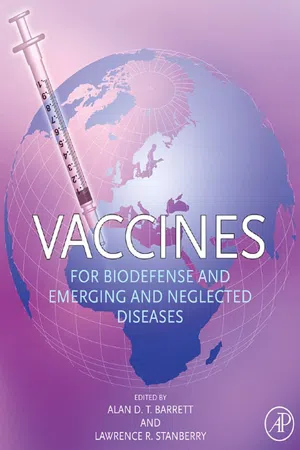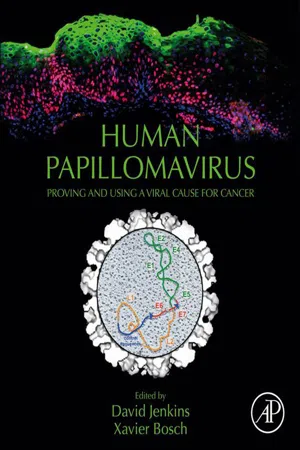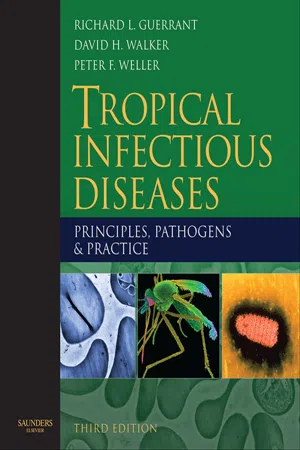Biological Sciences
Papillomavirus
Papillomavirus is a group of DNA viruses that can infect humans and animals. They are known for causing warts and are also associated with various types of cancers, including cervical cancer. The viruses are transmitted through skin-to-skin contact and can be prevented through vaccination.
Written by Perlego with AI-assistance
Related key terms
Related key terms
1 of 4
Related key terms
1 of 3
11 Key excerpts on "Papillomavirus"
- eBook - ePub
- RC Sobti, Aastha Sobti, RC Sobti, Aastha Sobti(Authors)
- 2023(Publication Date)
- CRC Press(Publisher)
23 Human Papillomavirus (HPV): Molecular Epidemiology of Infection and its Associated Diseases Abhishek Pandeya, Raj Kumar Khalko, Bharti Kotarya, Hema, Jitendra Kumar Yadav, and Sunil Babu Gosipatala Department of Biotechnology, School of Life Sciences, Babasaheb Bhimrao Ambedkar University, Lucknow, India Sudipta Saha Department of Pharmaceutical Sciences, School of Pharmaceutical Sciences, Babasaheb Bhimrao Ambedkar University, Lucknow, India R.C. Sobti Department of Biotechnology, Panjab University, Chandigarh, IndiaDOI: 10.1201/9781003220404-2523.1 Introduction
Papillomaviruses are a complex group of viruses that affects both humans and animals. Their origin seems to be related to changes in the epithelium of their ancestral host. The first reptiles appeared around 350 million years ago, and since then they have co-evolved with their respective hosts, with little Xeno transfer between species, which are now found in birds, reptiles, marsupials, and mammals. Thus, Human Papillomavirus (HPV) is an ancient DNA virus belonging to the Papillomaviridae family. The virions are small, non-enveloped, showing double-stranded DNA as the genome. They show circular DNA as the genome (approximately 8Kb), surrounded by an icosahedral capsid of 52–55 nm in diameter (Kirnbauer et al., 1992 ; Hagensee et al., 1993 ; Guan et al., 2017 ). These viruses are particularly tissue-specific and infect both the skin and the mucosal epithelium. More than 200 types of HPV strains/types have been characterized. The HPVs are classified into high-risk and low-risk types according to their propensity forcausing cancers. The International Agency for Research on Cancer identifies 12 high-risk types of HPV associated with human cancer (types 16, 18, 31, 33, 35, 39, 45, 51, 52, 56, 58, 59), of which 70% are associated with cervical cancer and additional types for which there is insufficient evidence for carcinogenicity (i.e., types 68 and 73) (Doorbar et al., 2012 ). Low-risk HPV includes 26, 40, 42, 53, 54, 55, 61, 62, 64, 66, and 67, with HPV 6 and 11 being the most common, which are 90% associated with genital warts and later on rarely cause cancer. These HPVs are responsible for causing Condylomata acuminata, a type of genital wart (Celewicz et al., 2020). Both high-risk and low-risk strains are observed to be present in an individual. Different worldwide HPV strains and their percentages are shown in Figure 23.1 - eBook - ePub
Singer and Monaghan's Cervical and Lower Genital Tract Precancer
Diagnosis and Treatment
- Albert Singer, Ashfaq Khan(Authors)
- 2014(Publication Date)
- Wiley-Blackwell(Publisher)
CHAPTER 2 Human Papillomaviruses in the pathogenesis of lower genital tract neoplasia2.1 Introduction
Since 1978, it has been well recognized that human Papillomavirus (HPV) infections are frequently associated with genital precancerous and cancerous lesions, namely cervical intraepithelial neoplasia (CIN), vulval intraepithelial neoplasia (VIN), vaginal intraepithelial neoplasia (VAIN), penile intraepithelial neoplasia (PIN), anal intraepithelial neoplasia (AIN), and invasive squamous cell carcinomas.2.2 Characteristics of human Papillomaviruses
Because viruses are obligate intracellular parasites, they cannot survive extended periods outside their target cells. However, they must be sufficiently stable in the environment to keep alive until they find a susceptible host. The first step in viral pathogenesis is to enter that susceptible host by using any of the available portals of entry, including the skin, mucosa of the eyes, oral cavity, upper gastrointestinal tract, respiratory tract, urogenital mucosa, or anal canal.HPV is a DNA virus that has a double-stranded, tightly coiled, circular genome of about 8000 Da. When the capsid is fully assembled, it forms an icosahedral structure. A complete virion measures approximately 55 nm in diameter (Figure 2.1 ). HPV has been classified into more than 100 types by DNA homology. The genetic structure of individual types is similar and the genome can be subdivided into three regions:- The upper regulatory region, containing binding sites for factors which regulate gene expression and DNA replication.
- The early region, coding for proteins which regulate viral transcription (E2); viral DNA replication (E1, E2); cell proliferation (E5, E6, E7); and virus release (E4).
- The late region, which codes for the two proteins forming the viral capsid (L1 and L2) (Figure 2.2 ).
Figure 2.1 - eBook - ePub
- Sunit Kumar Singh, Sunit Kumar Singh(Authors)
- 2015(Publication Date)
- Wiley-Blackwell(Publisher)
Chapter 13 Pathogenesis of Papillomaviruses in Humans John Doorbar Department of Pathology, University of Cambridge, Cambridge, United Kingdom 13.1 Introduction Papillomaviruses comprise a diverse group of viruses that infect both humans and animals. They are thought to have originated as the epithelium of their ancestral host evolved at the time that the first reptiles emerged around 350 million years ago. Since this time, they have co-evolved with their respective hosts with little cross-transfer between species, and are currently found in birds, reptiles, marsupials, and mammals, but not in amphibians or lower phylogenetic orders (Figure 13.1 a). Viruses that slowly co-evolve with their hosts in this way typically cause chronic inapparent infections, and generally do not cause serious disease. This is the case for many, if not most, Papillomaviruses, and indeed, human Papillomaviruses (HPVs) can be isolated from skin swabs and plucked hairs from normal immunocompetent individuals in the general population. As a result of such observations, it is thought that many HPVs may persist in the general population as commensal organisms rather than being associated with obvious disease pathology. Fig. 13.1 (a) Evolutionary tree showing the proposed appearance of an ancestral “Papillomavirus” between the branch point leading to amphibians and reptiles. It is thought that virus/host co-evolution has occurred during speciation, and that this has led to the widespread distribution of Papillomaviruses in organisms as diverse as snakes, birds, and mammals. (b) The HPV types found in humans fall into five genera, with the Alpha and the Beta/Gamma genera representing the largest groups. HPV types from the Alpha Genus are often classified as low-risk cutaneous, low-risk mucosal, or high-risk. The evolutionary tree is based on alignment of the E1, E2, L2, and L1 genes (Doorbar et al., 2012) - eBook - ePub
- Barry R. Bloom, Barry R. Bloom, Paul-Henri Lambert(Authors)
- 2002(Publication Date)
- Academic Press(Publisher)
6DISEASE STATES AND VACCINES: SELECTED CASES
PART J. Human Papillomaviruses1
LUTZ GISSMANN, Deutsches Krebsforschungszentrum, Im Neuenheimer Feld 242, 69120 Heidelberg, GermanyI. DESCRIPTION OF THE VIRUS
Human Papillomaviruses (HPV) can induce different diseases: cutaneous warts (papillomas), condylomata acuminata (genital warts), laryngeal papillomas, and intraepithelial lesions at the skin or mucosa, such as cervical intraepithelial neoplasia. These diseases are primarily self-limited, benign epithelial proliferations. Only some of them can, under rare circumstances, develop into malignant tumors. The most relevant clinical entity is cancer of the uterine cervix arising from intraepithelial neoplasias (CIN).The Papillomavirus family consists of more than 100 members, of which 86 are specific for humans and 16 for animal species (e.g., cattle, dogs, or rabbits) (for a review, see ref 1 ). The different human Papillomaviruses (HPV types) have been numbered according to their first descriptions as HPV 1, 2, etc. Classification is based upon the nucleotide sequences of the about 8000-base-pair-sized, double-stranded, circular DNA genome. Papillomaviruses share remarkable similarities in virus morphology, genome structure (6–8 early and 2 late genes), and biological properties (growth exclusively in differentiating epithelia). Yet the lesions that are arising as a consequence of an infection by a particular HPV type can differ in location, clinical appearance (exophytic warts, flat lesions), and natural history (self-limited and benign or exhibiting a potential toward malignant progression).Human Papillomaviruses are classified either according to their preferred tropism in skin or mucosa as cutaneous (e.g., HPV 1–4) or mucosal types (e.g., HPV 6, 16, 18) or according to their transforming potential as low-risk or high-risk types. Because the causal association between cervical cancer and infection by particular HPV types (16, 18, 31, 33, 45 and others) [2 ] has been firmly established through both experimental studies and epidemiological surveys (for reviews see refs 3 and 4 - John E. Craighead(Author)
- 2000(Publication Date)
- Academic Press(Publisher)
Rous and Kidd, 1936 ) had shown that the application of coal tar to the skin of Papillomavirus-infected rabbits accelerated development of tumors at this site. These uniquely simple, but insightful, experiments proved to be out of the mainstream of experimental cancer research at the time. Accordingly, an appreciation of their importance awaited the modern revolution of molecular virology during the last three decades of the twentieth century.Papillomaviruses and the papovaviruses (see Chapter 22 ) are classified as subfamilies of the Papovavirus family. Although the two have similarities, the viruses of these two subfamilies differ in size, and their DNA genomes are dissimilar. Papillomaviruses of humans (HPVs) are obligate parasites of epithelial cells, and their replication is intimately tied up with host cell multiplication and differentiation. HPVs are about 55 nm in diameter. They have a capsid comprised of 72 capsomeres arranged in icosahedral symmetry. The capsomeric protein is the major antigen of the virion, but the antigenic makeup of the virus has not been utilized for classification or typing purposes.Based on molecular analysis of the viral double-stranded DNA, 70 distinct types of Papillomavirus have now been identified in human tissues.1 The pathogenic importance of many of these virus types has yet to be established. While several individual types tend to be associated with distinct pathologic lesions in specific anatomic sites, considerable overlap exists. To a large extent, HPVs are not believed to be infectious for lesser species of animals, but the basis for this conclusion has not been rigorously examined. Similarly, the countless Papillomaviruses of subhuman mammalian and avian species are not thought to be infectious for humans, but, for obvious reasons, experimental proof is lacking (Rowson and Mahy, 1967 ). Many gaps currently exist in our knowledge of the Papillomaviruses and their pathogenic mechanisms. In part, these shortcomings and our lack of understanding of Papillomaviruses relate to our inability to grow these agents in cultured cells in vitro.- eBook - ePub
- M. K. Ramírez-Fort, F. Khan, P. L. Rady, S. K. Tyring(Authors)
- 2014(Publication Date)
- S. Karger(Publisher)
Human Papillomaviruses (HPVs) are epitheliotropic viruses which cause a variety of lesions at cutaneous and mucosal sites. Lesions range from the benign wart to dysplasia and neoplasia. Importantly, HPV has been shown to be etiological in several malignancies including cervical cancer, other anogenital cancers, oropharyngeal cancers, and cutaneous malignancies in susceptible individuals, causing an estimated 5.2% of virally associated cancers worldwide. HPVs are small, double-stranded DNA viruses of the Papillomaviridae family; to date 150 genotypes have been characterized with approximately one third targeting mucosal sites. Studies of viral oncogenesis have revealed that HPV early genes interact with and modulate mediators of cell growth and cell cycle progression in the host cell. Recent studies have shed light on more novel mechanisms employed by viral oncoproteins including epigenetic modifications, modulating apoptosis pathways, affecting cell morphology and regulating angiogenesis. These recent studies demonstrate that our current understanding is still very limited and will continue to evolve with future research. The purpose of this chapter is to provide a general overview of HPV oncogenesis and to highlight several etiological questions that we hope will be answered by future research.© 2014 S. Karger AG, BaselViruses have been increasingly recognized as causative in several human cancers, with an estimated 12% of human cancers caused by these infectious agents [1 ]. Importantly, human Papillomavirus (HPV) has been shown to be etiological in several malignancies including cervical cancer, other anogenital cancers, oropharyngeal cancers and nonmelanoma skin cancers in susceptible individuals, causing an estimated 5.2% of virally associated cancers worldwide [2 ] . HPVs are small, double-stranded DNA viruses of the Papillomaviridae family. At least 150 genotypes have been characterized with approximately one third targeting mucosal sites [3 , 4 ] . Infection with these epitheliotropic viruses most often causes benign proliferations or warts. A large proportion of HPV infections tend to cause self-limited infection and typically clear within 6-12 months [5 ] . Although persistent infection occurs in less than 10% of patients, longstanding infection increases the risk for developing precancerous and cancerous lesions [6 - eBook - ePub
- Esteban Domingo, Colin R. Parrish, John J. Holland(Authors)
- 2008(Publication Date)
- Academic Press(Publisher)
CHAPTER 18 Genome Diversity and Evolution of PapillomavirusesHans-Ulrich BernardAbstract
Papillomaviruses are small DNA viruses that infect cutaneous and mucosal epithelia of humans, other mammals, and of at least some birds. Due to their important role in human neoplastic disease, a huge nucleotide sequence database with hundreds of complete or partial genome sequences has become established. The analysis of these sequences led to the notion that Papillomaviruses genomes evolve very slowly, and nucleotide changes accumulate at a rate of about 1% per 100000 years, only slightly faster than the genomic changes of the hosts. The viruses form clades restricted to specific host species, although ancient diversification also gave rise to remotely related clades within individual host species. As phylogenetic trees of mammalian and bird Papillomaviruses have semblance to phylogenetic trees of the infected animal species, host-linked evolution suggests that the Papillomavirus genome organization is at least as old as the phylogeny of mammals and birds themselves, i.e. about 150 million years. While Papillomaviruses are thought to be unrelated to other DNA viruses, a major homology between replication initiation proteins points to a common ancestor that Papillomaviruses share with several other viruses and virus-like elements. The mechanisms of Papillomavirus evolution are still largely unclear due to the very similar genetic composition and biology of all Papillomaviruses.INTRODUCTION
The Papillomaviruses (Papillomaviridae ) form one of the seven families of human viruses with DNA genomes. They are thought not to be related to the polyomaviruses (Polyomaviridae ), with whom they had once been lumped into a single family, papovaviridae, a taxonomic unit that had been based mostly on the similarity of the viral particles and the common double-stranded DNA genomes. As genomes of viruses in the two families do not show much nucleotide sequence similarity, the papovaviridae have been eliminated as a valid taxon. When this book went to print, an exception to this generally hold view was about to be published (Woolford et al., - eBook - ePub
- N. James Maclachlan, Edward J Dubovi(Authors)
- 2010(Publication Date)
- Academic Press(Publisher)
From Fauquet, C.M., Mayo, M.A., Maniloff, J., Desselberger, U., Ball, L.A. (Eds.), Virus Taxonomy: Eighth Report of the International Committee on Taxonomy of Viruses, p. 239. Copyright © Elsevier (2005), with permission.Figure 11.3 Diagram of the genome of the bovine Papillomavirus (BPV-1). The viral dsDNA (size, 7945 base pairs; origin of replication—ori). The outer arrows indicate the protein-coding open reading frames (ORFs) and their direction of transcription (L1, L2—capsid proteins; E1–E8—nonstructural proteins).From King, A.M., Adams, M.J., Carstens, E.B., Lefkowitz, E.J. (Eds.), Virus Taxonomy: Ninth Report of the International Committee on Taxonomy of Viruses, p. 236. Copyright © Elsevier (2012), with permission.Virus Replication and Pathogenesis
Replication of Papillomaviruses is linked to the growth and differentiation of cells in stratified squamous epithelium. Infection starts when microtrauma allows the Papillomavirus to interact with the basement membrane, which then facilitates its infection via an unknown secondary receptor of a basal keratinocyte. After cell entry the Papillomavirus is transported to various locations, including the endoplasmic reticulum where it is completely or partially disassembled. The genome and some viral early (E) proteins enter the nucleus resulting in the production of 10–200 episomal copies of viral genomic DNA. Although the replication of Papillomavirus DNA during normal replication of basal keratinocytes maintains latent Papillomavirus infection, productive replication is dependent on terminal differentiation of an infected basal cell. Papillomaviruses are dependent on the nuclear machinery of the infected cell for replication. However, once a basal cell has terminally differentiated, it loses the ability to divide and thus degradation of the nucleus normally occurs. Therefore, a key property of Papillomaviruses is their ability, via expression of additional E genes, to force the infected cell to keep dividing and retain their nuclei. As the cells approach the surface of the epithelium, the Papillomavirus late (L) genes are expressed forming virus capsids. Virions are assembled in the nucleus and an infected cell may produce 10,000–100,000 new virus particles. Papillomaviruses do not cause cell lysis and virions are only released after the epithelial cell has been sloughed from the epithelial surface and degraded. Histologic evaluation of a latent infection does not reveal lesions whereas productive replication can lead to characteristic Papillomavirus-induced cellular changes (cytopathologic features) including enlarged cells with smudgy blue-grey cytoplasm, enlarged cells with shrunken nuclei surrounded by a clear halo (koilocytes), and rare indistinct eosinophilic or amphophilic intranuclear inclusions. Whether or not infection results in a papilloma is dependent on the increase in keratinocyte replication that is induced by the individual Papillomavirus. As most Papillomaviruses only mildly increase keratinocyte replication, they cause no clinically obvious lesion. However, a Papillomavirus infection that causes a marked increase in keratinocyte replication will induce an extensively or even massively thickened, folded epithelium and a visible papilloma (Fig. 11.4 - Alan D.T. Barrett, Lawrence R. Stanberry(Authors)
- 2009(Publication Date)
- Academic Press(Publisher)
Chapter 26 Human PapillomavirusWilliam Bonnez School of Medicine and Dentistry, University of Rochester, Rochester, NY, USAAbstractHuman Papillomaviruses (HPVs) include over 100 different genotypes that infect the stratified squamous epithelia and may cause proliferative lesions. Some of the HPVs are responsible for cutaneous warts, while one subset of HPVs is found in the skin lesions of epidermodysplasia verruciformis, a condition that leads to the development of cutaneous squamous cell carcinomas. A third subset of HPVs is associated with infections that can cause benign, premalignant, and malignant lesions not only of the genital tract, the anus, but also of the oropharynx. These lesions include external genital warts, intraepithelial neoplasias of the penis (PIN), anus (AIN), vulva (VIN), vagina (VAIN), and cervix (CIN), as well as cancer of the cervix. Cervical cancer is the second most commonly acquired cancer in women worldwide. This significant disease burden explains the great importance of genital (or mucosal) HPVs. The availability since 2006 of highly effective vaccines to prevent a large fraction of these morbidities has been a major advance whose promises are growing. The two vaccines available, Gardasil and Cervarix, are based on the expression of the major viral capsid protein in yeast or insect cells, and the spontaneous assembly of this protein into a noninfectious capsid called a virus-like particle (VLP), because it retains the appearance, size, and immunologic properties of the native, infectious viral particle.Gardasil is made of the VLPs of HPV types 6 and 11 that account for 90 of external genital warts, and of HPV types 16 and 18 that account for over 70% of cervical cancers worldwide. Cervarix is a bivalent vaccine that includes only HPV VLP of types 16 and 18. Trials have shown that these vaccines protect virtually 100% of the subjects against the immediate precursor to cancer, high-grade CIN, caused by the vaccine HPV types the subjects are naive to. Gardasil has received indications in the United States not only for the prevention in 9–26-year-old women of cervical cancer and CIN of all grades, but also for the prevention of VIN and VAIN grades 2 and 3, as well as of external genital warts. The most effective use of the vaccine is when administered before sexual debut, at a time the subject is naive for the infections caused by the HPV types included in the vaccine. The efficacy of the HPV vaccine has now been demonstrated up to the age of 45 years in women. Trials in men for the prevention of external genital warts are in progress, and could serve as a basis for the immunization of both males and females. The HPV vaccine, especially when it covers a broad range of viral types, holds the promise of not only affecting cervical cancer and its screening, but also of reducing the burden of the other cancers attributable to HPV, such as those of the vulva, vagina, penis, and anus, as well as a majority of oropharyngeal cancers. To attain these goals, maintenance of safety, favorable cost–benefit ratios, and broad delivery and accessibility of the vaccine will need to be achieved.- eBook - ePub
Human Papillomavirus
Proving and Using a Viral Cause for Cancer
- David Jenkins, Xavier Bosch(Authors)
- 2019(Publication Date)
- Academic Press(Publisher)
This system enables detailed genetic studies of virus–host cell interactions [151, 152] as well as investigations of virus neutralization by sera following HPV vaccination [153] and also antiviral drug discovery and validation [154, 155]. In addition, raft cultures developed from HPV 16 immortalized cervical keratinocytes that retain the ability to produce virions after stratification and tissue differentiation have enabled assessments of changes in global host gene expression compared to 3D cultures from normal cervical epithelia [156]. Together, such investigations are identifying the host cell proteins and pathways modulated by oncogenic HPVs across the disease spectrum and enabling informed consideration of targets for antiviral and anti-cancer therapeutic drug discovery. Conclusion Taken together, the early days between the discovery of HPV genomes in cervical cancers and the experimental validation of their oncogenic activity and key driver functions in 1990s and beyond revealed that HPV is the causative carcinogenic agent in uterine cervix and in malignancies of epithelia at other anatomic sites in males as well as females. Papillomavirus infections can introduce foreign viral genes into epithelial cells that may become integrated and become part of the genome of the emerging cancer cells. These genes clearly have oncogenic activities and largely explain the complex biology of these cancers caused by a virus that is not able to reproduce and multiply once integrated and partially deleted. Seen from the virus’ perspective, these are clearly “bad luck” chance aberrations of interactions between viral and human genes. For humans, the “bad luck” can be prevented by blocking primary infection through vaccination against HPV - Richard L. Guerrant, David H. Walker, Peter F. Weller(Authors)
- 2011(Publication Date)
- Saunders(Publisher)
47 Replication can be at a low level, the infection remaining latent, or it can be associated with abundant protein expression, causing active infection. The early proteins E1, E2, E5, E6, and E7 are found in the deeper layers of the epithelium, while E4, L1, and L2 are present in the superficial layers, where viral particles are assembled in the cell nucleus. Virions are released with desquamating cells.These viral changes of active infection are associated with formation of a wart or papilloma by proliferation of the stratum spinosum (acanthosis), stratum granulosum (parakeratosis), and stratum corneum (hyperkeratosis) (Fig. 80.1A ).48, 49 This proliferation, called papillomatosis, extends upwards, but also downwards with deepening of the normal scalloping of the basal membrane. One feature is quasi-pathognomonic, the presence in the upper stratum spinosum of large cells with a nucleus surrounded by a halo, koilocytes, which in a cytological sample signal the presence of HPV. A high-risk HPV infection may cause intraepithelial neoplasia (Fig. 80.1B ).48, 49 In that instance, there is proliferation of the basal layer. The cells start acquiring features associated with malignancy, including high nuclear-to-cytoplasmic ratio and greater number of mitoses. The presence of this basaloid proliferation confined to the lower third of the epithelium is grade 1. Grade 2 extends to the lower two-thirds, and grade 3 goes further. Involvement of the full thickness of the epithelium is carcinoma in situ , and breach of the basal membrane by this process defines invasive SCC. Dyskeratosis is also present.Figure 80.1 (A) Histologic features of a genital/cutaneous wart. (B) Histopathogenesis of cervical human Papillomavirus (HPV)-associated lesions (see text for details).(Reproduced from Bonnez W. Human Papillomavirus vaccines. In: Stanberry LR, Barrett ADT, eds. Vaccines for Biodefense and Emerging and Neglected Diseases. London: Elsevier; 2009:469–493.
Index pages curate the most relevant extracts from our library of academic textbooks. They’ve been created using an in-house natural language model (NLM), each adding context and meaning to key research topics.
Explore more topic indexes
Explore more topic indexes
1 of 6
Explore more topic indexes
1 of 4

